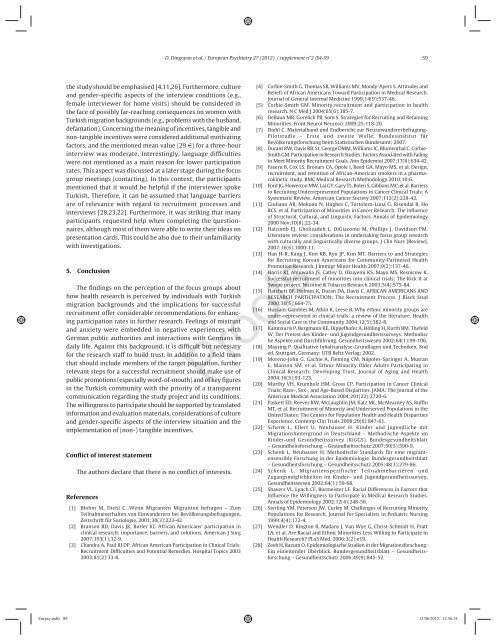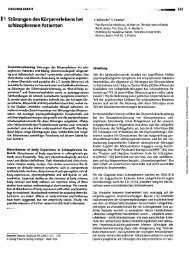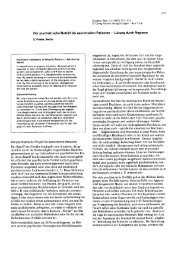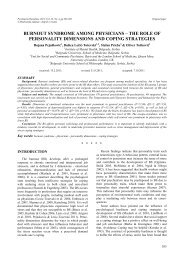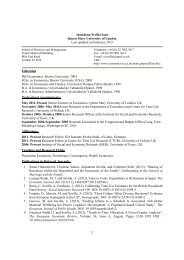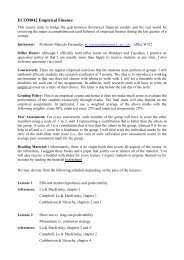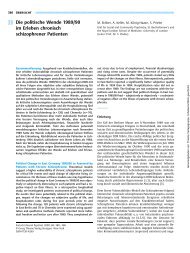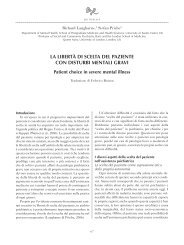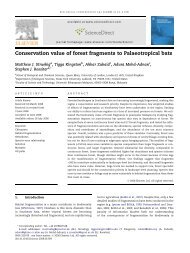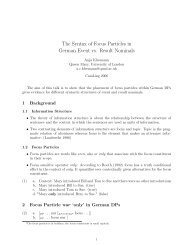Proofs - Personal Webspace for QMUL - Queen Mary, University of ...
Proofs - Personal Webspace for QMUL - Queen Mary, University of ...
Proofs - Personal Webspace for QMUL - Queen Mary, University of ...
You also want an ePaper? Increase the reach of your titles
YUMPU automatically turns print PDFs into web optimized ePapers that Google loves.
the study should be emphasised [4,11,26]. Furthermore, culture<br />
and gender- specifi c aspects <strong>of</strong> the interview conditions (e.g.,<br />
female interviewer <strong>for</strong> home visits) should be considered in<br />
the face <strong>of</strong> possibly far- reaching consequences on women with<br />
Turkish migration backgrounds (e.g., problems with the husband,<br />
defamation). Concerning the meaning <strong>of</strong> incentives, tangible and<br />
non- tangible incentives were considered additional motivating<br />
factors, and the mentioned mean value (29 €) <strong>for</strong> a three- hour<br />
interview was moderate. Interestingly, language diffi culties<br />
were not mentioned as a main reason <strong>for</strong> lower participation<br />
rates. This aspect was discussed at a later stage during the focus<br />
group meetings (contacting). In this context, the participants<br />
mentioned that it would be helpful if the interviewer spoke<br />
Turkish. There<strong>for</strong>e, it can be assumed that language barriers<br />
are <strong>of</strong> relevance with regard to recruitment processes and<br />
interviews [28,23,22]. Furthermore, it was striking that many<br />
participants requested help when completing the questionnaires,<br />
although most <strong>of</strong> them were able to write their ideas on<br />
presentation cards. This could be also due to their unfamiliarity<br />
with investigations.<br />
5. Conclusion<br />
The fi ndings on the perception <strong>of</strong> the focus groups about<br />
how health research is perceived by individuals with Turkish<br />
migration backgrounds and the implications <strong>for</strong> successful<br />
recruitment <strong>of</strong>fer considerable recommendations <strong>for</strong> enhancing<br />
participation rates in further research. Feelings <strong>of</strong> mistrust<br />
and anxiety were embedded in negative experiences with<br />
German public authorities and interactions with Germans in<br />
daily life. Against this background, it is diffi cult but necessary<br />
<strong>for</strong> the research staff to build trust. In addition to a fi eld team<br />
that should include members <strong>of</strong> the target population, further<br />
relevant steps <strong>for</strong> a successful recruitment should make use <strong>of</strong><br />
public promotions (especially word- <strong>of</strong>- mouth) and <strong>of</strong> key fi gures<br />
in the Turkish community with the priority <strong>of</strong> a transparent<br />
communication regarding the study project and its conditions.<br />
The willingness to participate should be supported by translated<br />
in<strong>for</strong>mation and evaluation materials, considerations <strong>of</strong> culture<br />
and gender- specifi c aspects <strong>of</strong> the interview situation and the<br />
implementation <strong>of</strong> (non- ) tangible incentives.<br />
Confl ict <strong>of</strong> interest statement<br />
The authors declare that there is no confl ict <strong>of</strong> interests.<br />
References<br />
[1] Blohm M, Diehl C. Wenn Migranten Migranten befragen – Zum<br />
Teilnahmeverhalten von Einwanderern bei Bevölkerungsbefragungen.<br />
Zeitschrift für Soziologie. 2001;30(3):223- 42.<br />
[2] Branson RD, Davis JK, Butler KL. African Americans’ participation in<br />
clinical research: importance, barriers, and solutions. American J Surg<br />
2007;193(1):32- 9.<br />
[3] Chandra A, Paul III DP. African American Participation in Clinical Trials:<br />
Recruitment Diffi culties and Potential Remedies. Hospital Topics 2003<br />
2003;81(2):33- 8.<br />
D. Dingoyan et al. / European Psychiatry 27 (2012) / supplement n°2 /S4-S9 S9<br />
[4] Corbie- Smith G, Thomas SB, Williams MV, Moody- Ayers S. Attitudes and<br />
Beliefs <strong>of</strong> African Americans Toward Participation in Medical Research.<br />
Journal <strong>of</strong> General Internal Medicine 1999;14(9):537- 46.<br />
[5] Corbie- Smith GM. Minority recruitment and participation in health<br />
research. N C Med J 2004;65(6):385- 7.<br />
[6] DeBaun MR, Gorelick PB, Som S. Strategies <strong>for</strong> Recruiting and Retaining<br />
Minorities. Front Neurol Neurosci 2009;25:118- 20.<br />
[7] Diehl C. Materialband und Endbericht zur Neuzuwandererbefragung-<br />
Pilotstudie – Erste und zweite Welle. Bundesinstitut für<br />
Bevölkerungs<strong>for</strong>schung beim Statistischen Bundesamt; 2007.<br />
[8] Durant RW, Davis RB, St. George DMM, Williams IC, Blumenthal C, Corbie-<br />
Smith GM. Participation in Research Studies: Factors Associated with Failing<br />
to Meet Minority Recruitment Goals. Ann Epidemiol 2007;17(8):634- 42.<br />
[9] Faseru B, Cox LS, Bronars CA, Opole I, Reed GA, Mayo MS, et al. Design,<br />
recruitment, and retention <strong>of</strong> African- American smokers in a pharmacokinetic<br />
study. BMC Medical Research Methodology 2010;10:6.<br />
[10] Ford JG, Howerton MW, Lai GY, Gary TL, Bolen S, Gibbons MC, et al. Barriers<br />
to Recruiting Underrepresented Populations to Cancer Clinical Trials: A<br />
Systematic Review. American Cancer Society 2007;112(2):228- 42.<br />
[11] Giuliano AR, Mokuau N, Hughes C, Tortolero- Luna G, Risendal B, Ho<br />
RCS, et al. Participation <strong>of</strong> Minorities in Cancer Research: The infl uence<br />
<strong>of</strong> Structural, Cultural, and Linguistic Factors. Annals <strong>of</strong> Epidemiology<br />
2000 Nov;10(8):22- 34.<br />
[12] Halcomb EJ, Gholizadeh L, DiGiacomo M, Phillips J, Davidson PM.<br />
Literature review: considerations in undertaking focus group research<br />
with culturally and linguistically diverse groups. J Clin Nurs [Review].<br />
2007;16(6):1000- 11.<br />
[13] Han H- R, Kang J, Kim KB, Ryu JP, Kim MT. Barriers to and Strategies<br />
<strong>for</strong> Recruiting Korean Americans <strong>for</strong> Community- Partnered Health<br />
Promotion Research. J Immigr Minor Health 2007;9(2):137- 46.<br />
[14] Harris KJ, Ahluwalia JS, Catley D, Okuyemi KS, Mayo MS, Resnicow K.<br />
Successful recruitment <strong>of</strong> minorities into clinical trials: The Kick It at<br />
Swope project. Nicotine & Tobacco Research 2003;5(4):575- 84.<br />
[15] Hatchett BF, Holmes K, Duran DA, Davis C. AFRICAN AMERICANS AND<br />
RESEARCH PARTICIPATION: The Recruitment Process. J Black Stud<br />
2000;30(5):664- 75.<br />
[16] Hussain- Gambles M, Atkin K, Leese B. Why ethnic minority groups are<br />
under- represented in clinical trials: a review <strong>of</strong> the literature. Health<br />
and Social Care in the Community 2004;12(5):382- 8.<br />
[17] Kamtsiuris P, Bergmann KE, Dippelh<strong>of</strong>er A, Hölling H, Kurth BM, Thefeld<br />
W. Der Pretest des Kinder- und Jugendgesundheitssurveys: Methodisc<br />
he Aspekte und Durchführung. Gesundheitswesen 2002;64(1):99- 106.<br />
[18] Mayring P. Qualitative Inhaltsanalyse- Grundlagen und Techniken. 8nd<br />
ed. Stuttgart, Germany: UTB Beltz Verlag; 2002.<br />
[19] Moreno- John G, Gachie A, Fleming CM, Nápoles- Springer A, Mutran<br />
E, Manson SM, et al. Ethnic Minority Older Adults Participating in<br />
Clinical Research: Developing Trust. Journal <strong>of</strong> Aging and Health<br />
2004;16(5):93- 123.<br />
[20] Murthy VH, Krumholz HM, Gross CP. Participation in Cancer Clinical<br />
Trials: Race- , Sex- , and Age- Based Disparities. JAMA: The Journal <strong>of</strong> the<br />
American Medical Association 2004;291(22):2720- 6.<br />
[21] Paskett ED, Reeves KW, McLaughlin JM, Katz ML, McAlearney AS, Ruffi n<br />
MT, et al. Recruitment <strong>of</strong> Minority and Underserved Populations in the<br />
United States: The Centers <strong>for</strong> Population Health and Health Disparities<br />
Experience. Contemp Clin Trials 2008;29(6):847- 61.<br />
[22] Schenk L, Ellert U, Neuhauser H. Kinder und Jugendliche mit<br />
Migrationshintergrund in Deutschland – Methodische Aspekte im<br />
Kinder- und Gesundheitssurvey (KiGGS). Bundesgesundheitsblatt<br />
– Gesundheits<strong>for</strong>schung – Gesundheitsschutz 2007;50(5):590- 9.<br />
[23] Schenk L, Neuhauser H. Methodische Standards für eine migrantensensible<br />
Forschung in der Epidemiologie. Bundesgesundheitsblatt<br />
– Gesundheits<strong>for</strong>schung – Gesundheitsschutz 2005;48(3):279- 86.<br />
[24] Schenk L. Migrantenspezifische Teilnahmebarrieren und<br />
Zugangsmöglichkeiten im Kinder- und Jugendgesundheitssurvey.<br />
Gesundheitswesen 2002;64(1):59- 68.<br />
[25] Shavers VL, Lynch CF, Burmeister LF. Racial Differences in Factors that<br />
Infl uence the Willingness to Participate in Medical Research Studies.<br />
Annals <strong>of</strong> Epidemiology 2002;12(4):248- 56.<br />
[26] Sterling YM, Peterson JW, Curley M. Challenges <strong>of</strong> Recruiting Minority<br />
Populations <strong>for</strong> Research. Journal <strong>for</strong> Specialists in Pediatric Nursing<br />
1999;4(4):172- 4.<br />
[27] Wendler D, Kington R, Madans J, Van Wye G, Christ- Schmidt H, Pratt<br />
LA, et al. Are Racial and Ethnic Minorities Less Willing to Participate in<br />
Health Research? PLoS Med. 2006;3(2):e19.<br />
[28] Zeeb H, Razum O. Epidemiologische Studien in der Migrations<strong>for</strong>schung:<br />
Ein einleitender Überblick. Bundesgesundheitsblatt – Gesundheits<strong>for</strong>schung<br />
– Gesundheitsschutz 2006;49(9):845- 52.<br />
<strong>Pro<strong>of</strong>s</strong>


